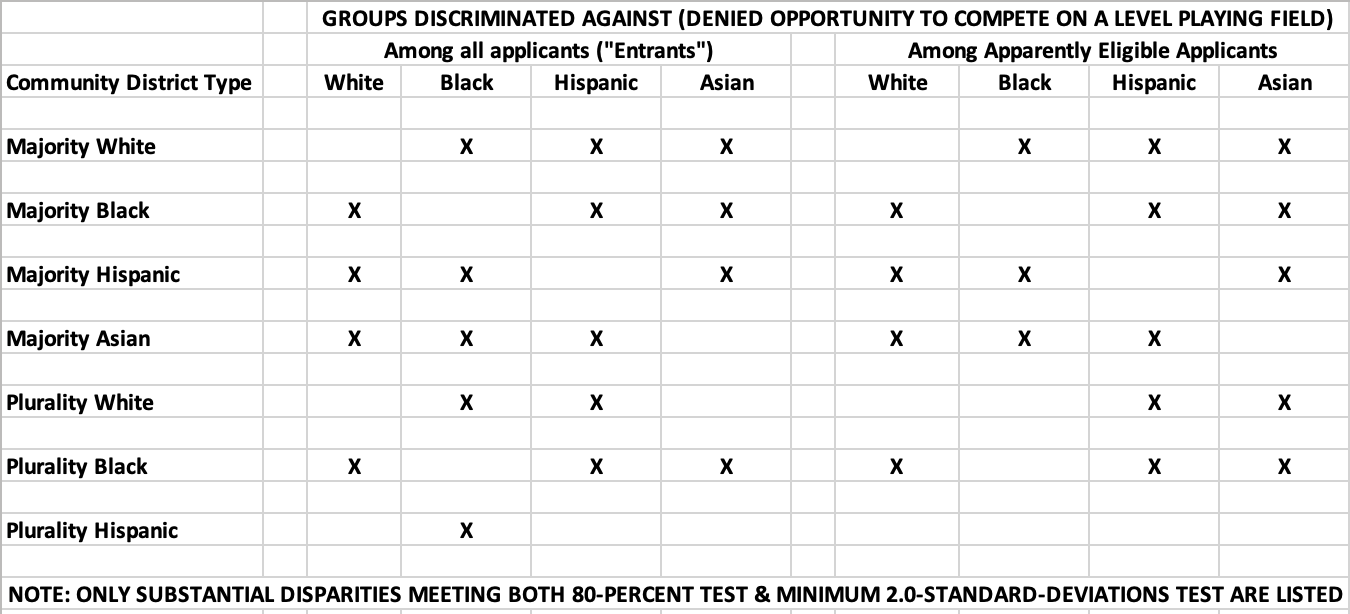NYC thwarted in bid to avoid trial in discrimination case challenging its outsider-restriction policy in affordable-housing lotteries
Disparate impacts
Simply put, the policy denies the opportunity to compete on a level playing field on the basis of race. Without the policy, the competition would be among all applicants, regardless of race, whomever they were and from wherever in New York City they were coming. For housing in majority White community districts (CDs), for example, the entire pool of apparently eligible applicants is 33.36 percent Black and only 10.57 percent White. This is very similar how the demographics of “outsiders” (those living outside of the CD): 34.08 percent Black and only 10.06 percent White. Nobody shaped that pool except the New Yorkers who decided to apply.
So, without the policy, lotteries would work the way you expect lotteries to work: everybody who applies is treated equally.
With the policy, though, the City makes things very different. The point of the policy is to NOT treat everyone equally, but to favor insiders. What does this mean practically? Well, for that housing in majority White CDs, the demographics of the “insiders” are dramatically different: only 10.62 percent Black (versus 34.08 percent of outsiders), and fully 26.63 percent White (versus only 10.06 percent of the outsiders). It is the much Whiter insider group that goes first in line for 50 percent of apartments (even though that insider group is only about 3 percent of all the apparently eligible applicants). See the chart below.

Since the policy operates on a community different level, it imposes different racial tilts in different parts of the city (depending on the racial demographics of the CD). This chart below summarizes the racial disparities caused by the policy for both for all applicants (“entrants”) and for the subset of entrants who, from analysis of their applications, are apparently-eligible.
This should have been the end of the story. But the Court then accepted (at least for now) the City’s premise that discrimination against one racial group in specified areas of the city could be offset by discrimiantion in favor of that racial group in another area of the city. Plaintiffs have, of course, filed a motion to reconsider this part of the opinion. In plaintiffs’ papers, they summarized the startling and unprecedented idea of “discrimination offset”:
The SJ Opinion effectively concluded that the law prohibiting disparate impact does not prevent a Black New Yorker living in Central Harlem who applies in a lottery for housing on the Upper East Side from being told, “Don’t complain that you are being disadvantaged on the basis of race in the lottery on the Upper East Side; at some point there will be a lottery in Central Harlem and you might decide to apply there and yield an advantage on the basis of race. Being discriminated in one place and potentially being favored in another place balance each other out, unldess you show that the Upper East Side lies within an ‘inherently more desirable’ community district.”
According to Craig Gurian, Anti-Discrimination Center’s executive director, “This kind of modern-day version of separate-but-equal is anathema to basic principles of civil rights — and basic principles of civil rights law. Leave aside the legal question for a moment: does this City really want to continue to be a place where there is never a level playing field to compete for desperately needed affordable housing? A place where your race will advantage you or disadvantage you depending on the demographics of the community district where the housing you apply to is located?”
>> We have always said that there is a simple solution: the City should take its thumb off the scale and honor the choices that New Yorkers are making via their applications — wherever they are coming from and wherever they wish to move.

